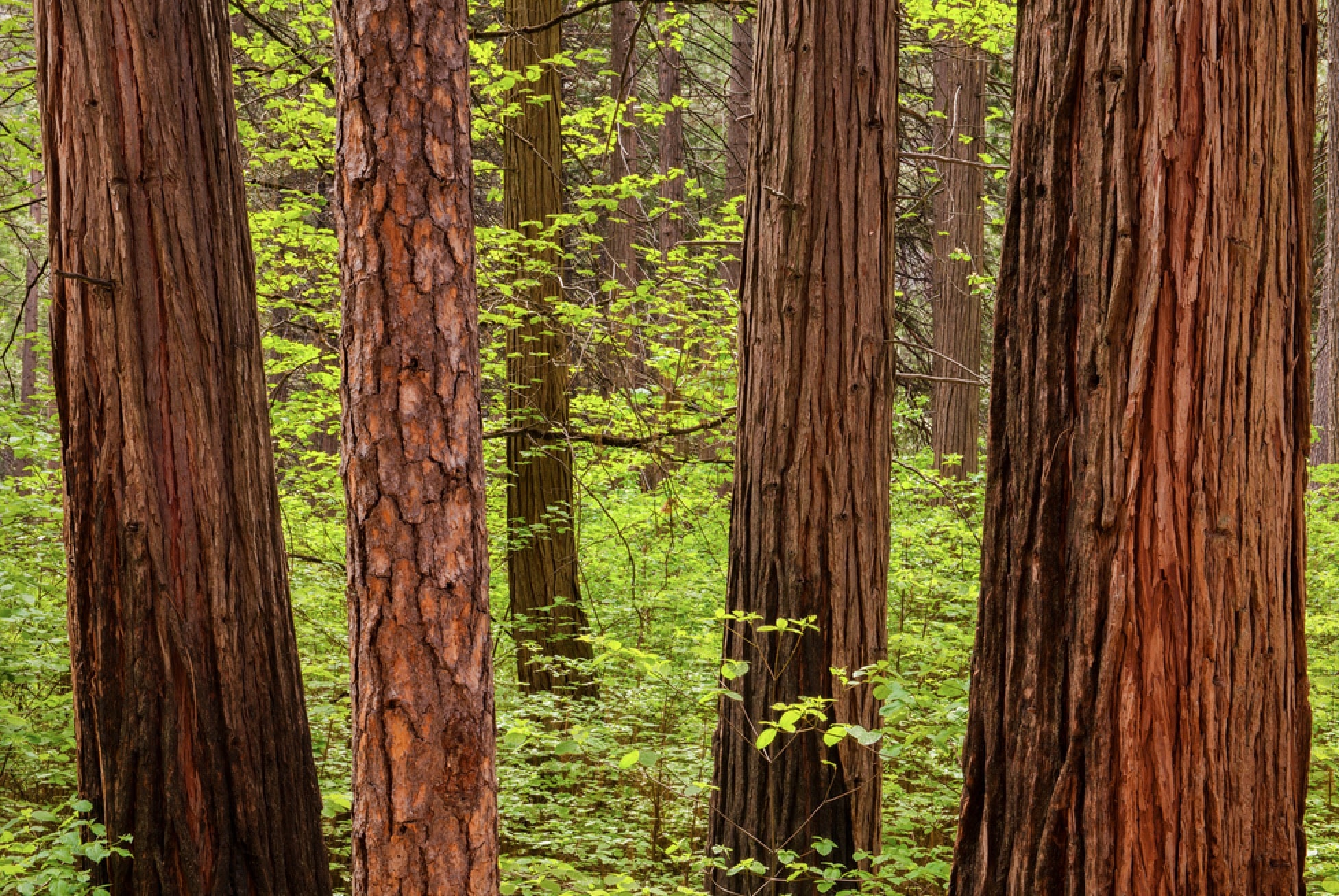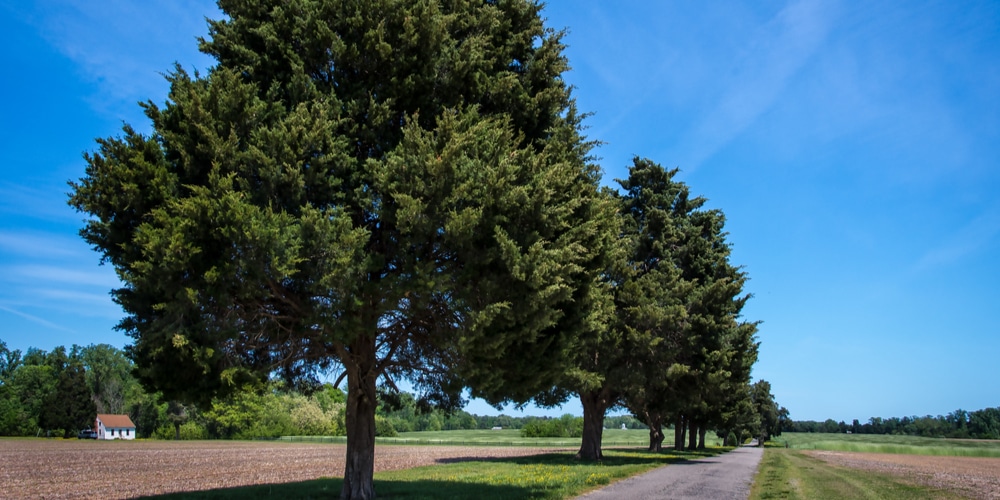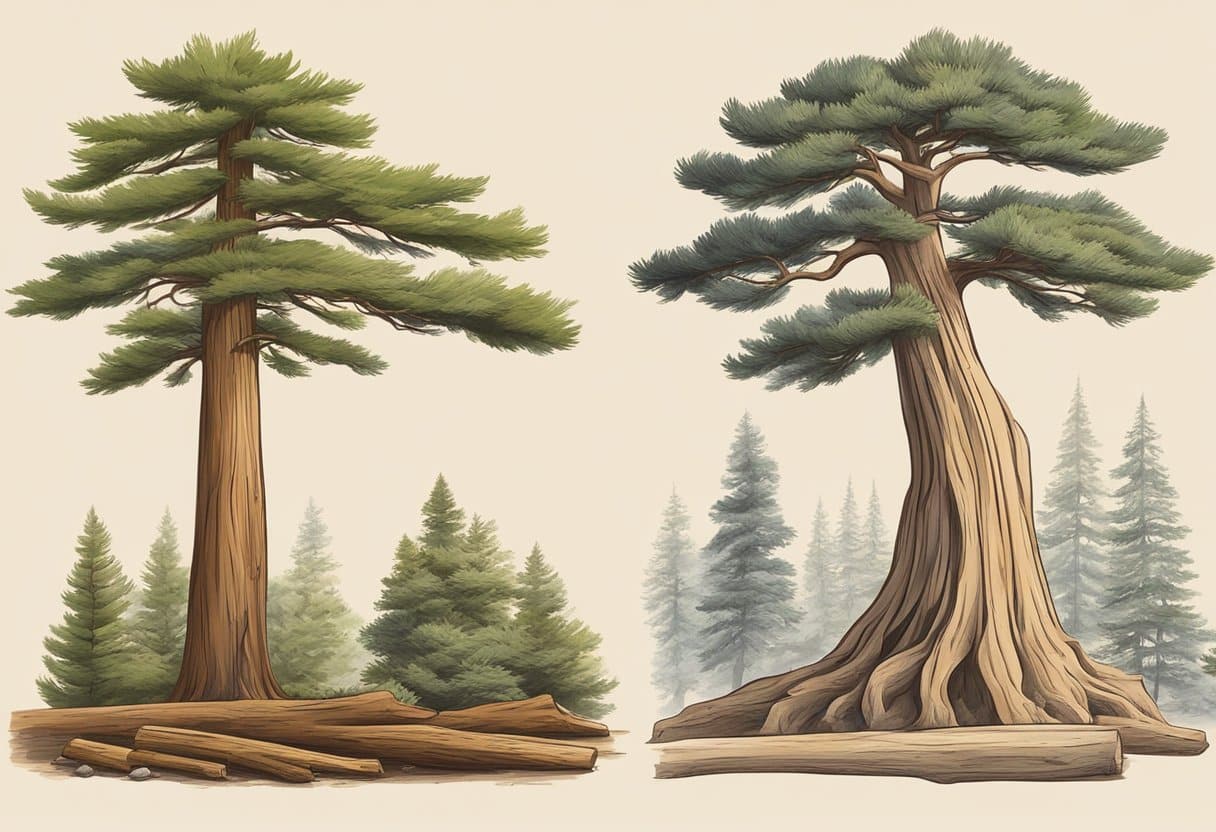Incense Cedar vs Red Cedar: An Overview

Tree Basics
Incense cedar and red cedar are two popular types of coniferous trees that are widely used for their wood. Incense cedar, also known as Calocedrus decurrens, is an evergreen tree that can grow up to 200 feet tall. It is native to Oregon and California and is known for its woody and ornamental properties.
On the other hand, red cedar, also known as Thuja plicata, is a coniferous tree that can grow up to 230 feet tall. It is native to western North America and is known for its durability and resistance to decay.
Both incense cedar and red cedar are commonly used for various purposes, such as furniture, decking, and siding.
However, they have different characteristics that make them suitable for different applications.
Incense cedar is known for its straight grain and fine texture, making it ideal for decorative purposes. Red cedar, on the other hand, is known for its natural resistance to decay and insects, making it ideal for outdoor applications.
Geographical Distribution
Incense cedar is native to the western United States, particularly in Oregon and California. It is commonly found in the Sierra Nevada and Cascade mountain ranges, where it grows in mixed coniferous forests.
Red cedar, on the other hand, is native to western North America, from Alaska to California.
It is commonly found in the Pacific Northwest, where it grows in moist, temperate rainforests.
Both incense cedar and red cedar are widely cultivated and can be found in other parts of the world. Incense cedar is commonly grown as an ornamental tree in gardens and parks, while red cedar is cultivated for its wood in various regions, including Europe, Asia, and New Zealand.
Physical Characteristics
When it comes to physical characteristics, there are some notable differences between incense cedar and red cedar. In this section, we’ll explore these differences in detail.
Color and Texture
One of the most obvious differences between the two types of cedar is their color.
While red cedar has a reddish hue, incense cedar tends to be more of a yellowish-brown color. In terms of texture, incense cedar has a fine, uniform texture, while red cedar has a rougher texture.
Cones and Foliage
Another difference between the two types of cedar is their cones and foliage.
Incense cedar has cones that are rounded and tend to grow in whorls of four, while red cedar has cones that are more elongated and tend to grow in whorls of three. In terms of foliage, incense cedar has a silvery sheen to its leaves, while red cedar has a more vibrant green color.
Bark Features
Finally, the bark of incense cedar and red cedar also differs in appearance.
Incense cedar has a smooth, rounded bark that is often described as “buttery,” while red cedar has a rougher, more rugged bark that is often used in decorative applications.
In summary, while both incense cedar and red cedar are types of cedar wood, they have distinct physical characteristics that set them apart from one another. From their color and texture to their cones and foliage, and even their bark features, each type of cedar has its own unique look and feel.
Related:
Wood Properties and Workability
Strength and Durability
Both incense cedar and red cedar are known for their durability and decay resistance, making them popular choices for outdoor applications such as siding, decking, and fencing. However, red cedar is generally considered to be stronger and more durable than incense cedar due to its higher density and tighter grain structure. This makes it better suited for applications that require high strength and dimensional stability.
Workability with Tools
Both incense cedar and red cedar are relatively easy to work with hand tools, making them popular choices for woodworking projects. However, incense cedar is generally considered to be easier to work with than red cedar due to its lower density and straighter grain. This makes it easier to cut, shape, and sand, making it a good choice for intricate woodworking projects.
Finishing
Both incense cedar and red cedar are known for their ability to hold paint and other finishes well. However, red cedar is generally considered to be a better choice for finishing due to its higher natural oil content, which helps to repel water and protect the wood from decay. Incense cedar, on the other hand, may require more coats of finish to achieve the same level of protection.
In terms of glues, both incense cedar and red cedar are compatible with most types of woodworking glue, including PVA, epoxy, and polyurethane. However, it is important to note that knots and other defects in the wood can affect the strength of the glue joint, so it is important to select high-quality, defect-free lumber for applications that require high strength.
Overall, both incense cedar and red cedar are excellent choices for woodworking and outdoor applications.
While red cedar is generally considered to be stronger and more durable, incense cedar is easier to work with and can be a good choice for intricate woodworking projects. When selecting lumber, it is important to consider the specific requirements of your project and choose the best wood for the job.
Uses of Cedar Wood
Cedar wood is a popular choice for a wide range of applications, from construction to furniture and musical instruments. In this section, we will explore some of the most common uses of cedar wood.
Construction and Exterior Applications
Cedar wood is commonly used in construction as a durable and rot-resistant material.
It is often used for sheathing, decking, and fence posts. Cedar wood is also a popular choice for exterior siding and shingles, as it is less expensive than other options like redwood or teak.
Furniture and Musical Instruments
Cedar wood is a popular choice for furniture and musical instruments.
Its light weight and natural resistance to decay make it an ideal material for chests, dressers, and other furniture pieces. Cedar wood is also commonly used for the tops of acoustic guitars, violins, and other stringed instruments, as it produces a warm and resonant sound.
Historical and Cultural Uses
Cedar wood has a long history of use in many cultures around the world.
In Native American cultures, cedar wood was often used for making bows and arrows, as well as for ceremonial purposes. In ancient Egypt, cedar wood was used for building ships and coffins, and it was also believed to have medicinal properties.
In conclusion, cedar wood is a versatile and durable material that has been used for a wide range of applications throughout history.
Whether you are building a new home, crafting a musical instrument, or simply looking for a beautiful and functional piece of furniture, cedar wood is an excellent choice.
Environmental Factors
When it comes to comparing incense cedar and red cedar, there are several environmental factors to consider. Moisture and weathering, as well as insect infestation and decay resistance, are all important considerations.
Moisture and Weathering
Both incense cedar and red cedar are known for their ability to resist moisture and weathering.
However, there are some differences between the two. Incense cedar has a higher resistance to moisture than red cedar, which makes it a better choice for outdoor use. Red cedar, on the other hand, is more resistant to weathering, which makes it a better choice for indoor use.
Insect Infestation and Decay Resistance
When it comes to insect infestation and decay resistance, both incense cedar and red cedar have their strengths. Incense cedar has a higher resistance to insect infestation than red cedar, which makes it a better choice for outdoor use. Red cedar, on the other hand, has a higher resistance to decay, which makes it a better choice for indoor use.
In terms of holding ability, incense cedar is a better choice for holding nails and screws than red cedar. This is because incense cedar has a harder and denser wood than red cedar. However, red cedar is a better choice for holding up against blunt nails, as it is more flexible than incense cedar.
Overall, when it comes to choosing between incense cedar and red cedar, it is important to consider the environmental factors that are most relevant to your intended use. By understanding the strengths and weaknesses of each type of wood, you can make an informed decision that will help you achieve the best possible results for your project.
Cedar Varieties Comparison
Incense Cedar vs White Cedar
Incense cedar and white cedar are both popular choices for outdoor furniture, decking, and siding. While they share some similarities, they also have some distinct differences.
Appearance
Incense cedar has a warm reddish-brown color with a straight grain, while white cedar has a lighter, almost white color with a tight, straight grain.
Durability
Incense cedar is naturally resistant to decay and insect damage, making it a good choice for outdoor applications. White cedar is also durable but may require more maintenance to protect against decay and insect damage.
Workability
Both types of cedar are easy to work with and can be easily cut, shaped, and sanded.
However, incense cedar may be more brittle and prone to splitting, while white cedar is more pliable.
Cost
Incense cedar is generally more expensive than white cedar due to its durability and natural resistance to decay and insects.
Red Cedar vs Alaska Cedar
Red cedar and Alaska cedar are two popular choices for outdoor applications, but they have some distinct differences.
Appearance
Red cedar has a reddish-brown color with a tight, straight grain, while Alaska cedar has a lighter, almost yellowish color with a more open, irregular grain.
Durability
Red cedar is naturally resistant to decay and insect damage, making it a good choice for outdoor applications. Alaska cedar is also durable but may require more maintenance to protect against decay and insect damage.
Workability
Both types of cedar are easy to work with and can be easily cut, shaped, and sanded. However, red cedar may be more prone to splitting, while Alaska cedar is more pliable.
Cost
Red cedar is generally more expensive than Alaska cedar due to its durability and natural resistance to decay and insects.
In summary, when choosing between cedar varieties, consider factors such as appearance, durability, workability, and cost to determine the best option for your specific application.
Pricing and Sustainability
When it comes to pricing, incense cedar is generally more affordable than red cedar. This is because incense cedar is more readily available and easier to harvest. However, keep in mind that pricing can vary depending on factors such as location and demand.
In terms of sustainability, both incense cedar and red cedar are considered to be good choices. They are both durable and resistant to rot and insect damage, making them ideal for outdoor use. However, it’s important to note that incense cedar is not as widely used as red cedar, which means that it may not be as readily available in some areas.
If sustainability is a top priority for you, you may also want to consider Port Orford Cedar. This type of cedar is known for its exceptional durability and resistance to decay, making it a popular choice for outdoor projects. However, it can be more expensive than incense cedar and red cedar due to its limited availability.
Overall, when it comes to choosing between incense cedar and red cedar, pricing and sustainability are important factors to consider. While incense cedar may be more affordable, red cedar is more widely used and may be easier to find in some areas. If sustainability is a top priority, Port Orford Cedar may be worth considering as well.
Taxonomy and Scientific Classification
If you are interested in understanding the taxonomy and scientific classification of incense cedar and red cedar, this section is for you.
Incense cedar, scientifically known as Libocedrus decurrens Torrey, belongs to the Cupressaceae family, which includes cypress, juniper, and redwood trees. Incense cedar is native to the western United States and Mexico, where it grows in the Sierra Nevada, Cascade, and Coast Mountain ranges.
It is a gymnosperm, which means it produces seeds without flowers or fruit.
Red cedar, on the other hand, is scientifically known as Juniperus virginiana L. and belongs to the Cupressaceae family as well.
It is native to eastern North America, from Maine to Florida and west to Missouri. Red cedar is also a gymnosperm and is commonly found in woodlands and along fence rows.
Native Americans have long used incense cedar for medicinal purposes, including treating respiratory ailments and skin conditions.
They also used the wood for making baskets, clothing, and canoes. Red cedar was also used for medicinal purposes and for making tools, furniture, and fences.
The taxonomy of incense cedar and red cedar is as follows:
| Incense Cedar | Red Cedar |
|---|---|
| Kingdom | Plantae |
| Division | Pinophyta |
| Class | Pinopsida |
| Order | Pinales |
| Family | Cupressaceae |
| Genus | Libocedrus |
| Species | L. decurrens |
It is worth noting that the scientific name of red cedar, Juniperus virginiana, is somewhat misleading, as it is not actually a cedar tree. Instead, it belongs to the juniper family.
In summary, incense cedar and red cedar belong to the Cupressaceae family, are gymnosperms, and have been used by Native Americans for medicinal and practical purposes.
While they share some similarities in taxonomy, they are distinct species with unique characteristics and uses.
Frequently Asked Questions
What are the uses of Incense Cedar?
Incense Cedar is a versatile wood that can be used for a variety of purposes. It is commonly used for fencing, decking, and siding. It is also used in the construction of outdoor furniture, pergolas, and arbors.
Additionally, it is used in the making of musical instruments, such as guitars and ukuleles.
What are the differences between Western Red Cedar and Incense Cedar?
Western Red Cedar and Incense Cedar are similar in appearance, but there are some differences. Western Red Cedar has a reddish-brown color, while Incense Cedar is more yellowish in color. Western Red Cedar is softer than Incense Cedar, which makes it easier to work with.
Additionally, Western Red Cedar has a stronger aroma than Incense Cedar.
Is Incense Cedar a true cedar?
No, Incense Cedar is not a true cedar. It is actually a member of the Cypress family.
What are the identifying features of Incense Cedar?
Incense Cedar has a straight grain and a fine, even texture. It has a yellowish color with streaks of brown. The wood has a pleasant aroma and is lightweight.
What are the benefits of using Incense Cedar for fencing?
Incense Cedar is a popular choice for fencing because it is naturally resistant to rot and decay. It is also resistant to insects, such as termites and carpenter ants. Additionally, it is lightweight and easy to work with, which makes it a good choice for DIY projects.
How much does Incense Cedar lumber cost?
The cost of Incense Cedar lumber can vary depending on the grade and thickness. On average, it can cost between $2 and $6 per linear foot. However, prices can fluctuate based on supply and demand.


